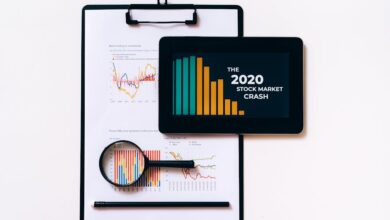Weathering the Economic Storm: Understanding Recession Indicators, Investment Strategies, and Government Responses

In an ever-evolving global economy, the specter of recession looms as a recurring challenge that can disrupt markets, alter consumer behavior, and reshape industries. As we navigate through cycles of growth and contraction, understanding the early warning signs of an impending economic downturn becomes crucial for individuals, businesses, and policymakers alike. This article delves into the multifaceted nature of recessions, exploring how they impact various sectors, the changing landscape of consumer behavior, and the critical role of government stimulus in mitigating their effects. Additionally, we will examine effective investment strategies during these turbulent times and the lessons gleaned from past recessions that remain relevant today. By arming ourselves with knowledge and insight, we can better prepare for and adapt to the challenges that recessions present, ultimately paving the way for resilience and recovery in an uncertain economic climate.
- 1. Recognizing the Red Flags: Early Warning Signs of an Economic Recession
- 2. Navigating the Storm: Strategies for Investing and Surviving Economic Downturns
- 3. Resilience in Crisis: The Role of Government Stimulus and Lessons from the Past
1. Recognizing the Red Flags: Early Warning Signs of an Economic Recession
Identifying early warning signs of an economic recession is crucial for businesses, investors, and policymakers to take proactive measures. Several key indicators can signal an impending downturn.
Firstly, a decline in consumer confidence often precedes a recession. When consumers feel uncertain about their financial future, they are likely to reduce spending, which can lead to decreased demand for goods and services. This change is often reflected in consumer sentiment surveys and retail sales data.
Secondly, a sustained drop in business investment can indicate trouble ahead. Companies may begin to pull back on capital expenditures, signaling a lack of confidence in future economic conditions. This can be observed through decreases in orders for durable goods and a slowdown in construction activity.
Another critical indicator is changes in employment trends. Rising unemployment claims and a slowdown in job creation can suggest that businesses are struggling, prompting them to cut back on hiring or even lay off workers. Additionally, leading economic indicators, such as the Purchasing Managers' Index (PMI), can provide insights into business sentiment and economic activity.
Financial markets often react to these signs as well. A prolonged decline in stock market performance can reflect investor apprehension about future growth, and an inverted yield curve—where short-term interest rates exceed long-term rates—has historically been a reliable predictor of recessions.
Lastly, external factors such as geopolitical tensions, trade disputes, or significant increases in commodity prices can also serve as red flags, influencing economic stability and growth prospects. Recognizing these early warning signs can empower stakeholders to adapt their strategies and mitigate potential risks associated with an economic recession.
2. Navigating the Storm: Strategies for Investing and Surviving Economic Downturns
Navigating an economic downturn requires a strategic approach to investing and managing finances. During recessions, market volatility typically increases, and asset prices can fluctuate significantly. Investors should consider several strategies to safeguard their portfolios and capitalize on potential opportunities.
First, diversification remains a cornerstone of a resilient investment strategy. By spreading investments across various asset classes—such as stocks, bonds, real estate, and commodities—investors can mitigate risk. Defensive sectors like utilities, healthcare, and consumer staples often perform better during downturns, as they provide essential goods and services that maintain demand even in tough economic times.
Second, maintaining a cash reserve is crucial. A liquidity cushion allows investors to seize opportunities when asset prices drop, as well as to weather any financial emergencies without the need to sell investments at a loss. This strategy also provides flexibility to adjust one’s portfolio in response to changing market conditions.
Third, investors should consider the long-term perspective. Economic downturns are often temporary, and markets tend to recover over time. Staying focused on long-term goals can help investors avoid panic selling during market fluctuations. Additionally, employing a systematic investment strategy, such as dollar-cost averaging, allows investors to buy more shares when prices are low, thereby reducing the average cost of their investments.
For those looking to invest during a recession, value investing can be particularly appealing. Identifying undervalued stocks with strong fundamentals can yield significant returns when the market stabilizes. Conversely, investors should be cautious of high-risk assets, as these can lead to greater losses during economic downturns.
Lastly, staying informed about macroeconomic indicators and trends can provide valuable insights into the timing of investments. Understanding factors such as unemployment rates, consumer spending, and government policies can help investors make more informed decisions.
In summary, navigating a recession involves a combination of strategic planning, diversification, and a focus on long-term growth. By employing these strategies, investors can enhance their resilience and position themselves for success in challenging economic environments.
3. Resilience in Crisis: The Role of Government Stimulus and Lessons from the Past
Government stimulus plays a crucial role in mitigating the adverse effects of economic recessions by providing financial support to individuals, businesses, and industries. During a downturn, stimulus measures can help stabilize demand, preserve jobs, and maintain consumer confidence. Historically, governments have employed various strategies, such as direct cash payments, tax relief, and increased public spending, to stimulate economic activity.
For instance, during the 2008 financial crisis, many countries implemented expansive fiscal policies, including the American Recovery and Reinvestment Act in the United States, which aimed to save and create jobs while promoting economic growth. These measures were pivotal in averting a deeper recession and facilitating a quicker recovery. Similarly, the COVID-19 pandemic saw unprecedented levels of government intervention, with stimulus packages designed to support affected sectors, such as travel and hospitality, while also addressing the immediate needs of individuals through unemployment benefits and direct payments.
Lessons from past economic crises highlight the importance of timely and targeted stimulus measures. Quick action can prevent businesses from collapsing and protect households from severe financial distress. However, the effectiveness of stimulus depends on a well-coordinated approach that considers the unique circumstances of each recession. For example, during the Great Depression, the New Deal programs implemented by President Franklin D. Roosevelt laid the groundwork for long-term economic reform, demonstrating that stimulus can also serve as a foundation for resilience and growth in the aftermath of a crisis.
As economies face future downturns, policymakers must draw from these historical examples to design stimulus packages that not only provide immediate relief but also foster sustainable recovery. This includes investing in infrastructure, education, and technology, which can enhance productivity and prepare economies for future challenges. Ultimately, the resilience of an economy in crisis hinges on the ability of government stimulus to adapt and respond effectively to the evolving economic landscape.
In conclusion, understanding the multifaceted nature of economic recessions is crucial for individuals, businesses, and policymakers alike. By recognizing early warning signs, such as declining GDP, rising unemployment, and shifts in consumer behavior, stakeholders can better prepare for the challenges ahead. The impact of recessions reverberates across various sectors, necessitating adaptive investment strategies that prioritize resilience and long-term growth. Government stimulus plays a vital role in mitigating the adverse effects of economic downturns, as evidenced by historical precedents that underscore the importance of timely intervention.
Moreover, the lessons learned from previous recessions illuminate the path forward, emphasizing the need for businesses to adopt proactive measures. This includes diversifying supply chains, enhancing financial literacy, and fostering innovation to navigate turbulent waters. As we move forward, it becomes increasingly clear that the ability to adapt and respond effectively to economic fluctuations not only safeguards individual and corporate interests but also contributes to a more stable and resilient economy. By preparing for potential downturns and leveraging the insights gained from past experiences, we can build a foundation for sustainable growth, even in the face of uncertainty.





